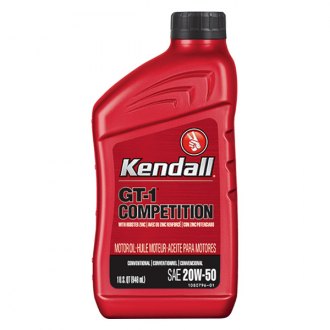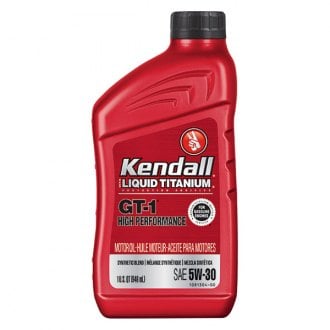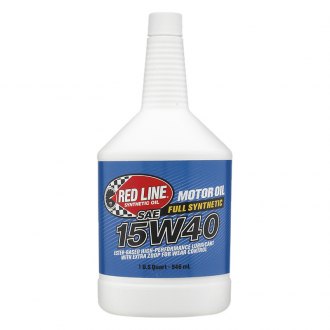Motor Oils

-
 Kendall®GT-1 High Performance™ SAE 20W-50 Conventional Motor Oil, 1 Quart (1081174)GT-1 High Performance™ SAE 20W-50 Conventional Motor Oil, 1 Quart (1081174) by Kendall®. This product is made of high-quality components to meet and exceed strict quality requirements. Designed using state-of-the-art technology and...$7.44
Kendall®GT-1 High Performance™ SAE 20W-50 Conventional Motor Oil, 1 Quart (1081174)GT-1 High Performance™ SAE 20W-50 Conventional Motor Oil, 1 Quart (1081174) by Kendall®. This product is made of high-quality components to meet and exceed strict quality requirements. Designed using state-of-the-art technology and...$7.44 -
 Kendall®GT-1 High Performance™ SAE 30 Conventional Motor Oil, 1 Quart (1074971)GT-1 High Performance™ SAE 30 Conventional Motor Oil, 1 Quart by Kendall®. This product is made of high-quality components to meet and exceed strict quality requirements. Designed using state-of-the-art technology and with customers...$7.80
Kendall®GT-1 High Performance™ SAE 30 Conventional Motor Oil, 1 Quart (1074971)GT-1 High Performance™ SAE 30 Conventional Motor Oil, 1 Quart by Kendall®. This product is made of high-quality components to meet and exceed strict quality requirements. Designed using state-of-the-art technology and with customers...$7.80 -
 Kendall®GT-1 High Performance™ SAE 5W-30 Conventional Motor Oil, 1 Quart (1081219)GT-1 High Performance™ SAE 5W-30 Conventional Motor Oil, 1 Quart (1081219) by Kendall®. This product is made of high-quality components to meet and exceed strict quality requirements. Designed using state-of-the-art technology and...$7.19
Kendall®GT-1 High Performance™ SAE 5W-30 Conventional Motor Oil, 1 Quart (1081219)GT-1 High Performance™ SAE 5W-30 Conventional Motor Oil, 1 Quart (1081219) by Kendall®. This product is made of high-quality components to meet and exceed strict quality requirements. Designed using state-of-the-art technology and...$7.19 -
 Red Line®20WT Racing SAE 5W-20 Full Synthetic Motor Oil, 1 Quart (10204)20WT Racing SAE 5W-20 Full Synthetic Motor Oil, 1 Quart (10204) by Red Line®. A favorite of 4-Cycle karters, low drag and serious protection. Racing oils provide more wear protection than motor oils for passenger vehicles, however,...$251.40
Red Line®20WT Racing SAE 5W-20 Full Synthetic Motor Oil, 1 Quart (10204)20WT Racing SAE 5W-20 Full Synthetic Motor Oil, 1 Quart (10204) by Red Line®. A favorite of 4-Cycle karters, low drag and serious protection. Racing oils provide more wear protection than motor oils for passenger vehicles, however,...$251.40 -
 Red Line®30WT Racing SAE 10W-30 Full Synthetic Motor Oil, 1 Quart (10304)30WT Racing SAE 10W-30 Full Synthetic Motor Oil, 1 Quart (10304) by Red Line®. If you watch your oil temp, you know this viscosity is likely the right one. Racing oils provide more wear protection than motor oils for passenger vehicles,...$251.40
Red Line®30WT Racing SAE 10W-30 Full Synthetic Motor Oil, 1 Quart (10304)30WT Racing SAE 10W-30 Full Synthetic Motor Oil, 1 Quart (10304) by Red Line®. If you watch your oil temp, you know this viscosity is likely the right one. Racing oils provide more wear protection than motor oils for passenger vehicles,...$251.40 -
 Red Line®50WT Racing SAE 15W-50 Full Synthetic Motor Oil, 1 Quart (10504)50WT Racing SAE 15W-50 Full Synthetic Motor Oil, 1 Quart (10504) by Red Line®. Racing oils provide more wear protection than motor oils for passenger vehicles, however, these products contain fewer detergents and are not suitable for...$251.40
Red Line®50WT Racing SAE 15W-50 Full Synthetic Motor Oil, 1 Quart (10504)50WT Racing SAE 15W-50 Full Synthetic Motor Oil, 1 Quart (10504) by Red Line®. Racing oils provide more wear protection than motor oils for passenger vehicles, however, these products contain fewer detergents and are not suitable for...$251.40 -
 Red Line®High Performance™ SAE 10W-30 Full Synthetic Motor Oil, 1 Gallon (11305)High Performance™ SAE 10W-30 Full Synthetic Motor Oil, 1 Gallon (11305) by Red Line®. Old-school viscosity for new school thinkers, gets up to temp quickly. Produced in only one top-of-the-line grade, these products offer the highest...$262.48
Red Line®High Performance™ SAE 10W-30 Full Synthetic Motor Oil, 1 Gallon (11305)High Performance™ SAE 10W-30 Full Synthetic Motor Oil, 1 Gallon (11305) by Red Line®. Old-school viscosity for new school thinkers, gets up to temp quickly. Produced in only one top-of-the-line grade, these products offer the highest...$262.48 -
 Red Line®High Performance™ SAE 10W-30 Full Synthetic Motor Oil, 1 Quart (11304)High Performance™ SAE 10W-30 Full Synthetic Motor Oil, 1 Quart (11304) by Red Line®. Old-school viscosity for new school thinkers, gets up to temp quickly. Produced in only one top-of-the-line grade, these products offer the highest...$203.64
Red Line®High Performance™ SAE 10W-30 Full Synthetic Motor Oil, 1 Quart (11304)High Performance™ SAE 10W-30 Full Synthetic Motor Oil, 1 Quart (11304) by Red Line®. Old-school viscosity for new school thinkers, gets up to temp quickly. Produced in only one top-of-the-line grade, these products offer the highest...$203.64 -
 Red Line®High Performance™ SAE 10W-40 Full Synthetic Motor Oil, 1 Gallon (11405)High Performance™ SAE 10W-40 Full Synthetic Motor Oil, 1 Gallon (11405) by Red Line®. Muscle car traditionalists love this one, with high zinc like Red Line others. Produced in only one top-of-the-line grade, these products offer the...$262.48
Red Line®High Performance™ SAE 10W-40 Full Synthetic Motor Oil, 1 Gallon (11405)High Performance™ SAE 10W-40 Full Synthetic Motor Oil, 1 Gallon (11405) by Red Line®. Muscle car traditionalists love this one, with high zinc like Red Line others. Produced in only one top-of-the-line grade, these products offer the...$262.48 -
 Red Line®High Performance™ SAE 15W-40 Full Synthetic Diesel Motor Oil, 1 Gallon (21405)High Performance™ SAE 15W-40 Full Synthetic Diesel Motor Oil, 1 Gallon (21405) by Red Line®. You physically can't find a higher-quality diesel motor oil. Produced in only one top-of-the-line grade, these products offer the highest...$262.48
Red Line®High Performance™ SAE 15W-40 Full Synthetic Diesel Motor Oil, 1 Gallon (21405)High Performance™ SAE 15W-40 Full Synthetic Diesel Motor Oil, 1 Gallon (21405) by Red Line®. You physically can't find a higher-quality diesel motor oil. Produced in only one top-of-the-line grade, these products offer the highest...$262.48 -
 Red Line®High Performance™ SAE 15W-40 Full Synthetic Diesel Motor Oil, 1 Quart (21404)High Performance™ SAE 15W-40 Full Synthetic Diesel Motor Oil, 1 Quart (21404) by Red Line®. You physically can't find a higher-quality diesel motor oil. Produced in only one top-of-the-line grade, these products offer the highest...$203.64
Red Line®High Performance™ SAE 15W-40 Full Synthetic Diesel Motor Oil, 1 Quart (21404)High Performance™ SAE 15W-40 Full Synthetic Diesel Motor Oil, 1 Quart (21404) by Red Line®. You physically can't find a higher-quality diesel motor oil. Produced in only one top-of-the-line grade, these products offer the highest...$203.64 -
 Red Line®High Performance™ SAE 15W-50 Full Synthetic Motor Oil, 1 Gallon (11505)High Performance™ SAE 15W-50 Full Synthetic Motor Oil, 1 Gallon (11505) by Red Line®. Fast and Furious? Your turbo motor will like Red Line cheesy reference. Produced in only one top-of-the-line grade, these products offer the highest...$262.48
Red Line®High Performance™ SAE 15W-50 Full Synthetic Motor Oil, 1 Gallon (11505)High Performance™ SAE 15W-50 Full Synthetic Motor Oil, 1 Gallon (11505) by Red Line®. Fast and Furious? Your turbo motor will like Red Line cheesy reference. Produced in only one top-of-the-line grade, these products offer the highest...$262.48 -
 Red Line®Professional Series SAE 5W-30 Full Synthetic Motor Oil, 1 Quart (12204)Professional Series SAE 5W-30 Full Synthetic Motor Oil, 1 Quart (12204) by Red Line®. This product is made of high-quality materials to serve you for years to come. Designed using state-of-the-art technology and with customers in mind....$71.94
Red Line®Professional Series SAE 5W-30 Full Synthetic Motor Oil, 1 Quart (12204)Professional Series SAE 5W-30 Full Synthetic Motor Oil, 1 Quart (12204) by Red Line®. This product is made of high-quality materials to serve you for years to come. Designed using state-of-the-art technology and with customers in mind....$71.94 -
 Red Line®Professional Series SAE 5W-30 Full Synthetic Motor Oil, 5 Quarts (12205)Professional Series SAE 5W-30 Full Synthetic Motor Oil, 5 Quarts (12205) by Red Line®. This product is made of high-quality materials to serve you for years to come. Designed using state-of-the-art technology and with customers in mind....$171.51
Red Line®Professional Series SAE 5W-30 Full Synthetic Motor Oil, 5 Quarts (12205)Professional Series SAE 5W-30 Full Synthetic Motor Oil, 5 Quarts (12205) by Red Line®. This product is made of high-quality materials to serve you for years to come. Designed using state-of-the-art technology and with customers in mind....$171.51 -
 Spec-D®Pro-Max SAE 5W-40 Synthetic Motor Oil, 1 Quart (SD-MXX-5W40)Pro-Max SAE 5W-40 Synthetic Motor Oil, 1 Quart by Spec-D®. This product is made of high-quality components to meet and exceed strict quality requirements. Designed using state-of-the-art technology and with customers in mind. It will...$7.63
Spec-D®Pro-Max SAE 5W-40 Synthetic Motor Oil, 1 Quart (SD-MXX-5W40)Pro-Max SAE 5W-40 Synthetic Motor Oil, 1 Quart by Spec-D®. This product is made of high-quality components to meet and exceed strict quality requirements. Designed using state-of-the-art technology and with customers in mind. It will...$7.63 -
 Motorcraft®SAE 0W-20 Full Synthetic Motor Oil, 5 Quarts (XO0W205QFS)SAE 0W-20 Full Synthetic Motor Oil, 5 Quarts (XO0W205QFS) by Motorcraft®. This product is made of high-quality components to meet and exceed strict quality requirements. Designed using state-of-the-art technology and with customers in...$33.20
Motorcraft®SAE 0W-20 Full Synthetic Motor Oil, 5 Quarts (XO0W205QFS)SAE 0W-20 Full Synthetic Motor Oil, 5 Quarts (XO0W205QFS) by Motorcraft®. This product is made of high-quality components to meet and exceed strict quality requirements. Designed using state-of-the-art technology and with customers in...$33.20 -
 Motorcraft®SAE 0W-20 Full Synthetic Motor Oil, 55 Gallons (XO0W20DFS)SAE 0W-20 Full Synthetic Motor Oil, 55 Gallons (XO0W20DFS) by Motorcraft®. This product is made of high-quality components to meet and exceed strict quality requirements. Designed using state-of-the-art technology and with customers in...$1,293.08
Motorcraft®SAE 0W-20 Full Synthetic Motor Oil, 55 Gallons (XO0W20DFS)SAE 0W-20 Full Synthetic Motor Oil, 55 Gallons (XO0W20DFS) by Motorcraft®. This product is made of high-quality components to meet and exceed strict quality requirements. Designed using state-of-the-art technology and with customers in...$1,293.08 -
 Liqui Moly®Special Tec AA™ SAE 5W-20 Full Synthetic Motor Oil, 1 Liter (1.06 Quarts) (7657)Special Tec AA™ SAE 5W-20 Full Synthetic Motor Oil, 1 Liter (1.06 Quarts) (7657) by Liqui Moly®. Modern premium class low-friction motor oil that was specially developed for year-round use in Asian and American vehicles. The...$13.39
Liqui Moly®Special Tec AA™ SAE 5W-20 Full Synthetic Motor Oil, 1 Liter (1.06 Quarts) (7657)Special Tec AA™ SAE 5W-20 Full Synthetic Motor Oil, 1 Liter (1.06 Quarts) (7657) by Liqui Moly®. Modern premium class low-friction motor oil that was specially developed for year-round use in Asian and American vehicles. The...$13.39 -
 Liqui Moly®Special Tec B FE™ SAE 5W-30 Full Synthetic Motor Oil, 20 Liters (21.13 Quarts) (22134)Special Tec B FE™ SAE 5W-30 Full Synthetic Motor Oil, 20 Liters (21.13 Quarts) (22134) by Liqui Moly®. Primarily developed for the requirement of specific BMW gasoline engines without particulate filter (GPF) from year 2002 and later....Ideal for gasoline enginesEspecially suitable for long intervals between oil changes$191.17
Liqui Moly®Special Tec B FE™ SAE 5W-30 Full Synthetic Motor Oil, 20 Liters (21.13 Quarts) (22134)Special Tec B FE™ SAE 5W-30 Full Synthetic Motor Oil, 20 Liters (21.13 Quarts) (22134) by Liqui Moly®. Primarily developed for the requirement of specific BMW gasoline engines without particulate filter (GPF) from year 2002 and later....Ideal for gasoline enginesEspecially suitable for long intervals between oil changes$191.17 -
 Mobil 1®Advanced™ SAE 5W-20 Full Synthetic Motor Oil, 1 Quart (125196)Advanced™ SAE 5W-20 Full Synthetic Motor Oil, 1 Quart (125196) by Mobil 1®. This product is made of high-quality components to meet and exceed strict quality requirements. Designed using state-of-the-art technology and with customers...$7.87
Mobil 1®Advanced™ SAE 5W-20 Full Synthetic Motor Oil, 1 Quart (125196)Advanced™ SAE 5W-20 Full Synthetic Motor Oil, 1 Quart (125196) by Mobil 1®. This product is made of high-quality components to meet and exceed strict quality requirements. Designed using state-of-the-art technology and with customers...$7.87 -
 Mobil 1®Advanced™ SAE 5W-30 Full Synthetic Motor Oil, 1 Quart (125195)Advanced™ SAE 5W-30 Full Synthetic Motor Oil, 1 Quart (125195) by Mobil 1®. This product is made of high-quality components to meet and exceed strict quality requirements. Designed using state-of-the-art technology and with customers...$7.62
Mobil 1®Advanced™ SAE 5W-30 Full Synthetic Motor Oil, 1 Quart (125195)Advanced™ SAE 5W-30 Full Synthetic Motor Oil, 1 Quart (125195) by Mobil 1®. This product is made of high-quality components to meet and exceed strict quality requirements. Designed using state-of-the-art technology and with customers...$7.62 -
 Mobil 1®Delvac™ 1300 Super SAE 15W-40 Synthetic Blend Heavy Duty Diesel Motor Oil, 2.5 Gallons (122493)Delvac™ 1300 Super SAE 15W-40 Synthetic Blend Heavy Duty Diesel Motor Oil, 2.5 Gallons (122493) by Mobil 1®. This product is made of high-quality components to meet and exceed strict quality requirements. Designed using...Made to provide the perfect lubricant solution for your needsDesigned with innovative manufacturing techniques$54.52
Mobil 1®Delvac™ 1300 Super SAE 15W-40 Synthetic Blend Heavy Duty Diesel Motor Oil, 2.5 Gallons (122493)Delvac™ 1300 Super SAE 15W-40 Synthetic Blend Heavy Duty Diesel Motor Oil, 2.5 Gallons (122493) by Mobil 1®. This product is made of high-quality components to meet and exceed strict quality requirements. Designed using...Made to provide the perfect lubricant solution for your needsDesigned with innovative manufacturing techniques$54.52 -
 Liqui Moly®Top Tec 6200 SAE 0W-20 Full Synthetic Motor Oil, 20 Liters (21.13 Quarts) (22186)Top Tec 6200 SAE 0W-20 Full Synthetic Motor Oil, 20 Liters (21.13 Quarts) (22186) by Liqui Moly®. Use only in gasoline and diesel engines with a particulate filter that require a lubricant of VW standard 508 00/509 00. Tested for use...Made to provide the perfect lubricant solution for your needsDesigned with innovative manufacturing techniques$240.55
Liqui Moly®Top Tec 6200 SAE 0W-20 Full Synthetic Motor Oil, 20 Liters (21.13 Quarts) (22186)Top Tec 6200 SAE 0W-20 Full Synthetic Motor Oil, 20 Liters (21.13 Quarts) (22186) by Liqui Moly®. Use only in gasoline and diesel engines with a particulate filter that require a lubricant of VW standard 508 00/509 00. Tested for use...Made to provide the perfect lubricant solution for your needsDesigned with innovative manufacturing techniques$240.55 -
 Motorcraft®SAE 5W-20 Full Synthetic High Mileage Motor Oil, 1 Quart (XO5W20QHM)SAE 5W-20 Full Synthetic High Mileage Motor Oil, 1 Quart by Motorcraft®. This product is made of high-quality components to meet and exceed strict quality requirements. Designed using state-of-the-art technology and with customers in...$4.41
Motorcraft®SAE 5W-20 Full Synthetic High Mileage Motor Oil, 1 Quart (XO5W20QHM)SAE 5W-20 Full Synthetic High Mileage Motor Oil, 1 Quart by Motorcraft®. This product is made of high-quality components to meet and exceed strict quality requirements. Designed using state-of-the-art technology and with customers in...$4.41 -
 CRP®Pentosin™ Pento Super Performance III SAE 5W-30 Full Synthetic Motor Oil, 1 Liter (1.06 Quarts) (8078106)Pentosin™ Pento Super Performance III SAE 5W-30 Full Synthetic Motor Oil, 1 Liter (1.06 Quarts) (8078106) by CRP®. 5W-30 Pento Super Performance III is a newly formulated high performance engine oil designed to be used in vehicles...$15.92
CRP®Pentosin™ Pento Super Performance III SAE 5W-30 Full Synthetic Motor Oil, 1 Liter (1.06 Quarts) (8078106)Pentosin™ Pento Super Performance III SAE 5W-30 Full Synthetic Motor Oil, 1 Liter (1.06 Quarts) (8078106) by CRP®. 5W-30 Pento Super Performance III is a newly formulated high performance engine oil designed to be used in vehicles...$15.92 -
 CRP®Pentosin™ Pento Super Performance III SAE 5W-30 Full Synthetic Motor Oil, 5 Liters (5.28 Quarts) (8078206)Pentosin™ Pento Super Performance III SAE 5W-30 Full Synthetic Motor Oil, 5 Liters (5.28 Quarts) (8078206) by CRP®. 5W-30 Pento Super Performance III is a newly formulated high performance engine oil designed to be used in vehicles...$66.54
CRP®Pentosin™ Pento Super Performance III SAE 5W-30 Full Synthetic Motor Oil, 5 Liters (5.28 Quarts) (8078206)Pentosin™ Pento Super Performance III SAE 5W-30 Full Synthetic Motor Oil, 5 Liters (5.28 Quarts) (8078206) by CRP®. 5W-30 Pento Super Performance III is a newly formulated high performance engine oil designed to be used in vehicles...$66.54 -
 Castrol®Edge™ SAE 5W-30 Full Synthetic SP Motor Oil, 1 Quart (15D3BC)Edge™ SAE 5W-30 Full Synthetic SP Motor Oil, 1 Quart (15D3BC) by Castrol®. Castrol Edge with Fluid Titanium Technology, is Castrol’s strongest oil and the natural choice for drivers who want the best combination of sludge...$10.24
Castrol®Edge™ SAE 5W-30 Full Synthetic SP Motor Oil, 1 Quart (15D3BC)Edge™ SAE 5W-30 Full Synthetic SP Motor Oil, 1 Quart (15D3BC) by Castrol®. Castrol Edge with Fluid Titanium Technology, is Castrol’s strongest oil and the natural choice for drivers who want the best combination of sludge...$10.24 -
 Mopar®MaxPro™ SAE 0W-30 Full Synthetic Motor Oil, 1 Quart (68523988AA)MaxPro™ SAE 0W-30 Full Synthetic Motor Oil, 1 Quart by Mopar®. This product is made of high-quality components to meet and exceed strict quality requirements. Designed using state-of-the-art technology and with customers in mind. It...Made to provide the perfect lubricant solution for your needsDesigned with innovative manufacturing techniques$13.30
Mopar®MaxPro™ SAE 0W-30 Full Synthetic Motor Oil, 1 Quart (68523988AA)MaxPro™ SAE 0W-30 Full Synthetic Motor Oil, 1 Quart by Mopar®. This product is made of high-quality components to meet and exceed strict quality requirements. Designed using state-of-the-art technology and with customers in mind. It...Made to provide the perfect lubricant solution for your needsDesigned with innovative manufacturing techniques$13.30 -
 Shell®Pennzoil Platinum™ SAE 5W-20 Full Synthetic Motor Oil, 1 Quart (550022686)Pennzoil Platinum™ SAE 5W-20 Full Synthetic Motor Oil, 1 Quart (550022686) by Shell®. Pennzoil® motor oil is formulated with Active Cleansing Technology. At Pennzoil we’re committed to engineering motor oils that are proven to...$8.42
Shell®Pennzoil Platinum™ SAE 5W-20 Full Synthetic Motor Oil, 1 Quart (550022686)Pennzoil Platinum™ SAE 5W-20 Full Synthetic Motor Oil, 1 Quart (550022686) by Shell®. Pennzoil® motor oil is formulated with Active Cleansing Technology. At Pennzoil we’re committed to engineering motor oils that are proven to...$8.42 -
 Idemitsu®SAE 20W-50 Full Synthetic Rotary Motor Oil, 1 Quart (30018101-75000C010)SAE 20W-50 Full Synthetic Rotary Motor Oil, 1 Quart (30018101-75000C010) by Idemitsu®. Idemitsu 0W-16 SP/GF-6B is a fully synthetic, ultra-low viscosity formulation with robust additive technology, enabling engines to achieve maximum...$17.69
Idemitsu®SAE 20W-50 Full Synthetic Rotary Motor Oil, 1 Quart (30018101-75000C010)SAE 20W-50 Full Synthetic Rotary Motor Oil, 1 Quart (30018101-75000C010) by Idemitsu®. Idemitsu 0W-16 SP/GF-6B is a fully synthetic, ultra-low viscosity formulation with robust additive technology, enabling engines to achieve maximum...$17.69
Oil lubricates and cools engine parts and keeps your engine clean. The oil is drawn through a pickup tube and screen from the oil pan and circulated throughout the engine under pressure by the oil pump. The oil is filtered and then sent to the engine bearings and valvetrain. Splash from the connecting rods, and on some engines jets of oil, lubricate the cylinder walls and cool the underside of the pistons. Oil then returns through passages to the oil pan.
There are two kinds of engine oil, conventional petroleum oil and synthetic. Conventional oil is refined from crude oil pumped out of the ground, while synthetic oil is chemically constructed in the laboratory from various raw materials. Synthetic oil is superior to conventional oil at temperature extremes because it flows better at cold temperatures for better startup protection and resists high temperatures that can cause ordinary oil to breakdown.
All oils have additive packages. Detergents keep varnish and sludge from forming while dispersants keep harmful materials suspended so they can be drained out. Extreme pressure additives and friction modifiers reduce wear for longer engine life and reduce friction for better performance and mileage. Viscosity improvers minimize viscosity change with temperature. Other additives reduce foaming and oxidation, neutralize acids and combustion byproducts, and prevent rust and corrosion. The additive package in synthetic oil is generally superior to that of conventional oil.
Oils are classified by grade and standard. The grade is a numerical index established by the Society of Automotive Engineers (SAE) that represents the oil’s viscosity, or resistance to flow, commonly referred to as “weight”. In this system a 10 weight oil flows easier than a 50 weight oil at the same temperature. Most vehicle manufacturers recommend a multi-grade oil like 10W-30 (the w stands for winter, not weight) because it will flow easily like a 10 weight oil under cold temperatures, but have the characteristics of a 30 weight oil at 212°F. It is best to use the grade of oil recommended by the vehicle manufacturer.
The American Petroleum Institute (API) evaluates lubricants against minimum performance standards, with service classes for gasoline and diesel engines. The gasoline engine standard begins with “S”, while the diesel engine standard begins with “C”. The current gas engine standard is SN, with CJ-4, CI-4, and CI-4 PLUS current for diesel engines. The standard and grade can be found in the API service symbol, or “Donut”, on the oil container. Some oils may also have the API “Starburst” symbol, indicating the oil meets fuel economy standards set by the International Lubricant Specification Advisory Committee (ILSAC).
Featured Brands
Related Categories
 Transmission Fluids, Oils & Additives
Transmission Fluids, Oils & Additives Engine Oil Additives
Engine Oil Additives Differential Lubricants
Differential Lubricants Transfer Case Lubricants
Transfer Case Lubricants Antifreeze & Additives
Antifreeze & Additives CV Joint Lubricants
CV Joint Lubricants Air Filter Maintenance
Air Filter Maintenance Power Steering Fluid
Power Steering Fluid Anti-Seize Lubricants
Anti-Seize Lubricants Bearing Lubricants
Bearing Lubricants Multi-Purpose Lubricants
Multi-Purpose Lubricants A/C Chemicals
A/C Chemicals Adhesives & Sealants
Adhesives & Sealants Suspension Lubricants
Suspension Lubricants Cleaners & Degreasers
Cleaners & Degreasers Gasketing
Gasketing Hand Care
Hand Care Brake Fluids & Lubricants
Brake Fluids & Lubricants Fuel System Additives
Fuel System Additives Lubricants
Lubricants Electrical Lubricants
Electrical Lubricants Thread Compounds
Thread Compounds



























